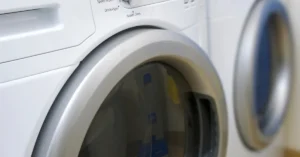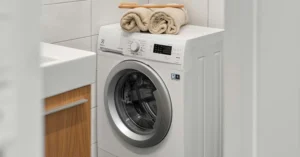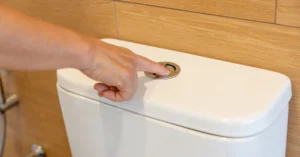When your toilet won’t flush, it can turn a normal day into a stressful situation. This frustrating problem happens to almost every homeowner at some point, but the good news is that most toilet won’t flush issues can be fixed without calling a plumber. Understanding why your toilet won’t flush and knowing how to fix it can save you time, money, and embarrassment.
A toilet that won’t flush properly affects your daily routine and can even lead to bigger plumbing problems if not addressed quickly. The key is knowing what to look for and having the right approach to fix the issue safely and effectively.
How Your Toilet Actually Works
Before diving into why your toilet won’t flush, it helps to understand how toilets work. When you push the handle, a chain lifts the flapper at the bottom of the tank. This allows water to flow from the tank into the bowl, creating the force needed to push waste through the trap and into the main drain.
Once the tank empties, the flapper closes and the fill valve refills the tank with fresh water. This simple but effective system has several parts that can cause problems when your toilet won’t flush properly.
7 Most Common Reasons Your Toilet Won’t Flush
1. Clogged Toilet or Drain
The most frequent reason a toilet won’t flush is a simple clog. Plumbing experts say that using too much toilet paper or flushing items that shouldn’t go down the toilet causes most clogs. Items like wet wipes, feminine hygiene products, cotton swabs, and even excess toilet paper can block the pipes.
Signs your toilet won’t flush due to a clog include water rising in the bowl, slow drainage, or complete blockage. The good news is that most clogs can be cleared with a toilet plunger. Make sure you’re using a toilet plunger, not a sink plunger – toilet plungers have a flange that creates better suction.
To clear a clog, place the plunger over the drain hole at the bottom of the bowl. Push and pull firmly for several seconds, then lift the plunger to see if water drains. You may need to repeat this process several times. If plunging doesn’t work, try a toilet auger to reach deeper clogs.
2. Low Water Level in the Tank
When your toilet won’t flush with enough force, low water level in the tank is often the culprit. Your toilet needs adequate water in the tank to create the pressure necessary for a strong flush. If the water level is too low, you’ll get a weak flush or no flush at all.
Remove the toilet tank lid and check the water level. It should be about one inch below the rim of the tank or at the water line marked inside the tank. If the level is too low, check if the water supply valve behind the toilet is fully open. This valve should be turned counterclockwise as far as it will go.
Low water levels can also indicate problems with the fill valve or float mechanism. These parts control how much water enters the tank after each flush.
3. Broken or Warped Flapper
The flapper is the rubber seal at the bottom of your toilet tank that lifts when you flush. When your toilet won’t flush properly, a damaged flapper is often to blame. Over time, flappers can warp, crack, or become brittle, preventing them from sealing properly.
A broken flapper means water continuously leaks from the tank into the bowl, preventing the tank from filling completely. This leaves insufficient water for the next flush. You might hear your toilet running constantly, which is a clear sign of flapper problems.
To check your flapper, remove the tank lid and look at the rubber piece covering the flush valve opening. If it’s warped, cracked, or doesn’t sit flat against the valve seat, it needs replacement. Flappers are inexpensive and available at any hardware store. Make sure to get the right size – measure your current flapper or take it with you to ensure a proper fit.
4. Disconnected or Broken Handle
Sometimes the reason your toilet won’t flush is as simple as a broken handle connection. The handle connects to the flapper through a chain or wire mechanism. If this connection breaks or comes loose, pressing the handle won’t lift the flapper to start the flushing process.
Remove the tank lid and push the handle while watching the internal mechanism. You should see the chain lift and pull the flapper up. If nothing happens, check if the chain has come loose from either the handle arm or the flapper. The chain should have just a small amount of slack – not too tight and not too loose.
If the handle itself is broken or extremely loose, you may need to replace it. This is usually a straightforward repair that involves unscrewing the old handle and installing a new one.
5. Problems with the Fill Valve
The fill valve controls water flow into the tank after flushing. When your toilet won’t flush due to fill valve problems, you might notice the tank takes too long to refill or doesn’t fill at all. This can be caused by mineral buildup, debris, or simply wear and tear over time.
To test your fill valve, lift the float arm or ball. If water starts flowing, the fill valve is working but may need adjustment. If no water flows, the fill valve likely needs cleaning or replacement. Toilet repair specialists recommend replacing fill valves that are more than seven years old, as they’re prone to failure.
Replacing a fill valve is more complex than other repairs but still manageable for most homeowners. Turn off the water supply, drain the tank, and follow the manufacturer’s instructions for your specific toilet model.
6. Clogged Rim Jets
The small holes around the rim of your toilet bowl are called rim jets. These holes direct water into the bowl during flushing. When your toilet won’t flush effectively, clogged rim jets could be reducing water flow and flush power.
Mineral deposits from hard water, particularly calcium and lime, commonly build up in these small openings. You might not notice this problem at first, but over time, blocked rim jets significantly weaken your toilet’s flushing ability.
To clean rim jets, use a wire coat hanger or small bottle brush to clear each hole. You can also use a toilet bowl cleaner designed to dissolve mineral deposits. Pour the cleaner into the tank and let it work through the rim jets during flushing, or apply it directly to the rim holes and scrub gently.
7. Water Supply Issues
Sometimes when your toilet won’t flush, the problem isn’t with the toilet itself but with your home’s water supply. If there’s no water reaching the toilet, it obviously can’t flush properly.
First, check if other faucets in your home have water. If they don’t, you may have a broader water supply issue that requires contacting your water provider. If other fixtures work fine, check that the toilet’s water supply valve (usually located behind the toilet near the floor) is fully open.
Low water pressure can also affect toilet performance. If your home has consistently low water pressure, it may take longer for the toilet tank to refill, affecting the next flush.
When to Call a Professional Plumber
While many toilet won’t flush problems can be solved with DIY repairs, some situations require professional help. Call a licensed plumber if you’ve tried the basic troubleshooting steps and your toilet still won’t flush properly.
Professional help is especially important if you notice water leaking around the base of the toilet, which could indicate a failed wax ring or cracked toilet bowl. Strange noises like gurgling when other fixtures drain might signal plumbing vent issues that require professional diagnosis.
If you’ve replaced parts and your toilet still won’t flush, there might be deeper issues with your drain lines or sewer connection. Professional plumbers have specialized tools like drain cameras and powerful augers to diagnose and fix complex problems safely.
Preventing Future Toilet Problems
Preventing your toilet won’t flush problems is easier and cheaper than fixing them. Start by being mindful of what goes down your toilet. Only flush toilet paper and human waste – never flush wipes, feminine products, cotton swabs, or other items that can cause clogs.
Regular maintenance helps catch small problems before they become big ones. Clean your toilet regularly, including the rim jets and tank components. Check the flapper, chain, and other moving parts periodically for signs of wear.
Consider signing up for The Solid Care Plan for just $144 per year. This preventive maintenance program includes regular inspections that can identify potential toilet problems before they leave you dealing with a toilet that won’t flush at the worst possible moment.
Quick Emergency Fixes
If your toilet won’t flush and you need an immediate solution, you can manually flush it by pouring a bucket of water directly into the bowl. Use about one gallon of water and pour it quickly to create enough force to clear the trap.
This emergency method works when the toilet mechanism is broken but the drain isn’t clogged. It’s a temporary solution while you gather the tools and parts needed for a proper repair.
For ongoing toilet won’t flush issues, turn off the water supply to prevent potential flooding. The shutoff valve is usually located behind the toilet near the floor – turn it clockwise to stop water flow.
Tools You’ll Need for DIY Repairs
Having the right tools makes fixing a toilet that won’t flush much easier. Keep a toilet plunger specifically designed for toilets – it has a flange that creates better suction than regular sink plungers.
A toilet auger or snake can clear deeper clogs that plungers can’t reach. Basic tools like screwdrivers, pliers, and an adjustable wrench handle most toilet repairs. Rubber gloves and old towels are essential for cleanup during repairs.
Most toilet parts like flappers, fill valves, and handles are available at hardware stores and home improvement centers. When buying replacement parts, take the old part with you or take photos to ensure you get the correct size and type.
Don’t Let Toilet Problems Disrupt Your Life
A toilet that won’t flush doesn’t have to ruin your day. Most of these problems have straightforward solutions that homeowners can handle with basic tools and a little patience. The key is identifying the root cause and taking the appropriate action.
Start with the simplest solutions first – check for clogs, verify water levels, and inspect visible components like the flapper and chain. Many toilet won’t flush problems can be resolved in just a few minutes with these basic checks.
When simple fixes don’t work, don’t hesitate to call professional help. Trying to force repairs beyond your skill level can lead to more expensive damage. Professional plumbers can quickly diagnose complex issues and get your toilet working properly again.
If you’re dealing with persistent toilet problems or need help with any plumbing repairs, professional help is just a phone call away. Don’t let a toilet that won’t flush stress you out – contact experienced plumbers who can solve the problem quickly and prevent future issues.
Remember, regular maintenance and proper use are your best defenses against toilet problems. With the right approach, you can keep your toilet flushing smoothly for years to come, avoiding the frustration and inconvenience of dealing with a toilet that won’t flush when you need it most.



